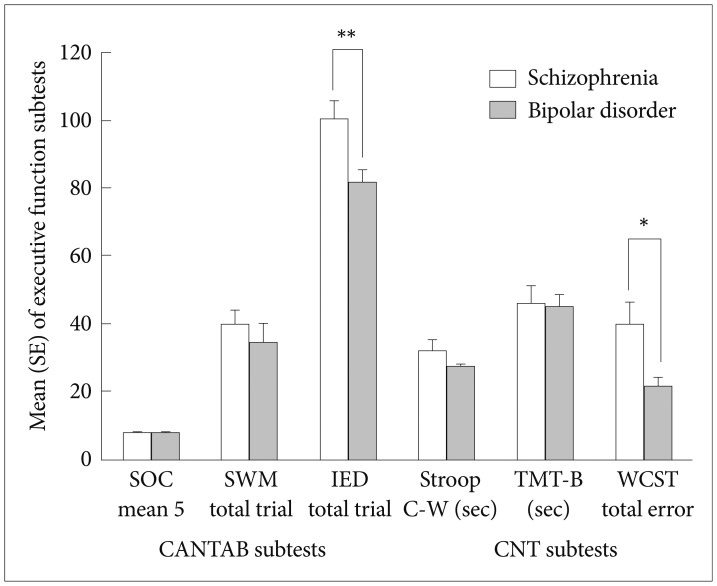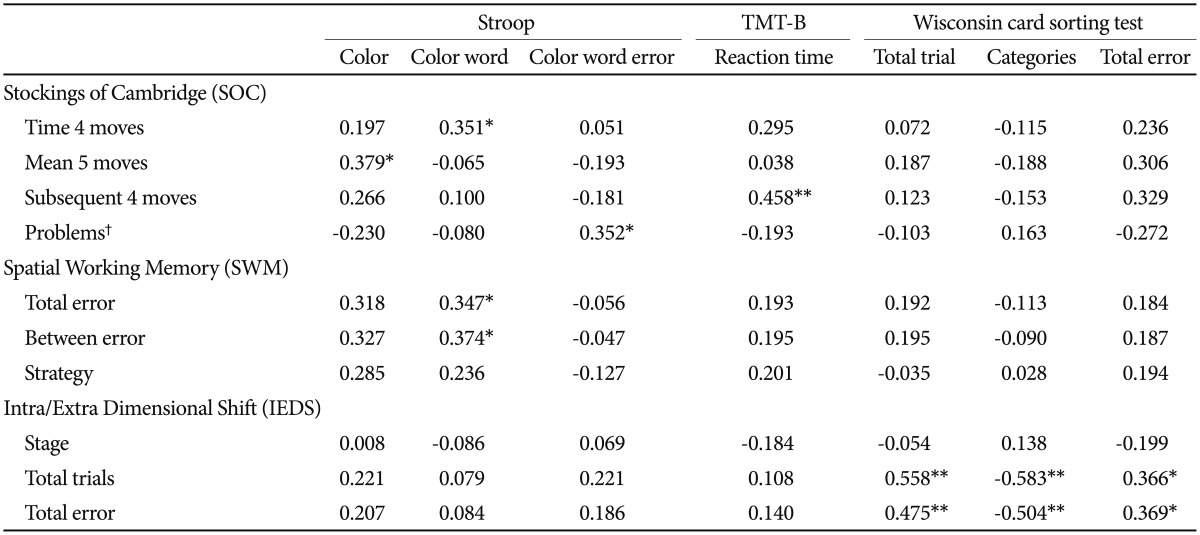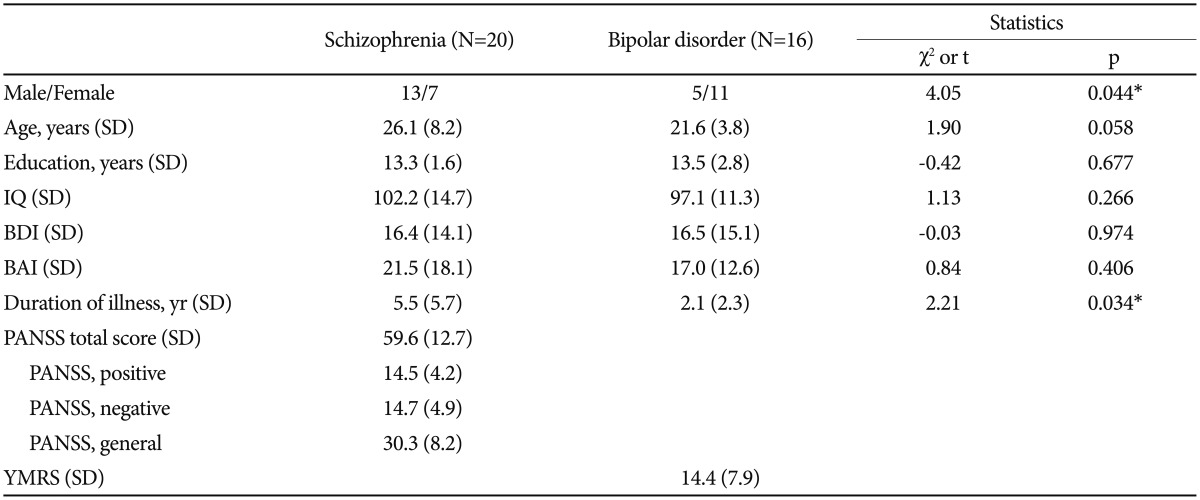1. Green MF, Kern RS, Heaton RK. Longitudinal studies of cognition and functional outcome in schizophrenia: implications for MATRICS. Schizophr Res 2004;72:41-51. PMID:
15531406.


2. Pantelis C, Barnes T, Nelson HE, Tanner S, Weatherley L, Owen AM, et al. Frontal-striatal cognitive deficits in patients with chronic schizophrenia. Brain 1997;120:1823-1843. PMID:
9365373.


3. Laws KR. A meta-analytic review of Wisconsin Card Sort studies in schizophrenia: general intellectual deficit in disguise? Cogn Neuropsychiatry 1999;4:1-30. PMID:
16571497.


4. Jurado MB, Rosselli M. The elusive nature of executive functions: a review of our current understanding. Neuropsychol Rev 2007;17:213-233. PMID:
17786559.


5. Alvarez JA, Emory E. Executive function and the frontal lobes: a meta-analytic review. Neuropsychol Rev 2006;16:17-42. PMID:
16794878.


6. Lezak MD. Neuropsychological Assessment. 4e. USA: Oxford University Press; 2004.
7. Quraishi S, Frangou S. Neuropsychology of bipolar disorder: a review. J Affect Disord 2002;72:209-226. PMID:
12450638.


8. Green MF. Cognitive impairment and functional outcome in schizophrenia and bipolar disorder. J Clin Psychiatry 2006;67(Suppl 9):3-8. PMID:
16965182.

9. Ritsner MS, Blumenkrantz H, Dubinsky T, Dwolatzky T. The detection of neurocognitive decline in schizophrenia using the Mindstreams Computerized Cognitive Test Battery. Schizophr Res 2006;82:39-49. PMID:
16377157.


10. Kane RL, Kay GG. Computerized assessment in neuropsychology: a review of tests and test batteries. Neuropsychol Rev 1992;3:1-117. PMID:
1300218.


11. Levaux MN, Potvin S, Sepehry AA, Sablier J, Mendrek A, Stip E. Computerized assessment of cognition in schizophrenia: promises and pitfalls of CANTAB. Eur Psychiatry 2007;22:104-115. PMID:
17227707.


12. Lyoo IK, Kwon JS, Ha KS. Development and standardization of the computerized higher cortical function assessment for Korean adults. J Korean Neuropsychiatr Assoc 2002;41:538-550.
13. Lowe C, Rabbitt P. Test/re-test reliability of the CANTAB and ISPOCD neuropsychological batteries: theoretical and practical issues. Cambridge Neuropsychological Test Automated Battery. International Study of Post-Operative Cognitive Dysfunction. Neuropsychologia 1998;36:915-923. PMID:
9740364.


14. ├ēgerh├Īzi A, Berecz R, Bartok E, Degrell I. Automated Neuropsychological Test Battery (CANTAB) in mild cognitive impairment and in Alzheimer's disease. Prog Neuropsychopharmacol Biol Psychiatry 2007;31:746-751. PMID:
17289240.


15. Barrett SL, Mulholland CC, Cooper SJ, Rushe TM. Patterns of neurocognitive impairment in first-episode bipolar disorder and schizophrenia. Br J Psychiatry 2009;195:67-72. PMID:
19567899.


16. Sahakian BJ. Computerized assessment of neuropsychological function in Alzheimer's disease and Parkinson's disease. Int J Geriatr Psychiatry 1990;5:211-213.

17. Sahakian BJ, Owen AM. Computerized assessment in neuropsychiatry using CANTAB: discussion paper. J R Soc Med 1992;85:399-402. PMID:
1629849.


18. Robbins TW, James M, Owen AM, Sahakian BJ, McInnes L, Rabbitt P. Cambridge Neuropsychological Test Automated Battery (CANTAB): A factor analytic study of a large sample of normal elderly volunteers. Dement Geriatr Cogn Disord 1994;5:266-281.

19. Elliott R, McKenna PJ, Robbins TW, Sahakian BJ. Neuropsychological evidence for frontostriatal dysfunction in schizophrenia. Psychol Med 1995;25:619-630. PMID:
7480441.


20. Kiehl KA, Smith AM, Hare RD, Liddle PF. An event-related potential investigation of response inhibition in schizophrenia and psychopathy. Biol Psychiatry 2000;48:210-221. PMID:
10924664.


21. Badcock JC, Michie P, Johnson L, Combrinck J. Acts of control in schizophrenia: dissociating the components of inhibition. Psychol Med 2002;32:287-297. PMID:
11866323.


22. Matza LS, Buchanan R, Purdon S, Brewster-Jordan J, Zhao Y, Revicki DA. Measuring changes in functional status among patients with sch-izophrenia: the link with cognitive impairment. Schizophr Bull 2006;32:666-678. PMID:
16829550.



23. Association AP. Diagnostic criteria from DSM-IV. Washington DC: Amer Psychiatric Pub Inc; 1994.
24. Ha KS, Kwon JS, Lyoo IK. Development and standardization of the computerized attention assessment for Korean adults. J Korean Neuropsychiatr Assoc 2002;41:335-346.
25. Kay SR, Fiszbein A, Opler LA. The positive and negative syndrome scale (PANSS) for schizophrenia. Schizophr Bull 1987;13:261-276. PMID:
3616518.


26. Young RC, Biggs JT, Ziegler VE, Meyer DA. A rating scale for mania: reliability, validity and sensitivity. Br J Psychiatry 1978;133:429-435. PMID:
728692.


27. Hamilton M. Development of a rating scale for primary depressive illness. Br J Soc Clin Psychol 1967;6:278-296. PMID:
6080235.


28. Hamilton M. The assessment of anxiety states by rating. Br J Med Psychol 1959;32:50-55. PMID:
13638508.


29. Robbins TW, James M, Owen AM, Sahakian BJ, Lawrence AD, McInnes L, et al. A study of performance on tests from the CANTAB battery sensitive to frontal lobe dysfunction in a large sample of normal volunteers: implications for theories of executive functioning and cognitive aging. Cambridge Neuropsychological Test Automated Battery. J Int Neuropsychol Soc 1998;4:474-490. PMID:
9745237.

30. Schretlen DJ, Cascella NG, Meyer SM, Kingery LR, Testa SM, Munro CA, et al. Neuropsychological functioning in bipolar disorder and sch-izophrenia. Biol Psychiatry 2007;62:179-186. PMID:
17161829.


31. Joyce E, Hutton S, Mutsatsa S, Gibbins H, Webb E, Paul S, et al. Executive dysfunction in first-episode schizophrenia and relationship to duration of untreated psychosis: the West London Study. Br J Psychiatry Suppl 2002;43:s38-s44. PMID:
12271799.


32. Lewandowski KE, Cohen BM, Ûngur D. Evolution of neuropsychological dysfunction during the course of schizophrenia and bipolar disorder. Psychol Med 2011;41:225-241. PMID:
20836900.


33. Tam WCC, Liu Z. Comparison of neurocognition between drug-free patients with schizophrenia and bipolar disorder. J Nerv Ment Dis 2004;192:464-470. PMID:
15232316.


34. McGrath J, Scheldt S, Welham J, Clair A. Performance on tests sensitive to impaired executive ability in schizophrenia, mania and well controls: acute and subacute phases. Schizophr Res 1997;26:127-137. PMID:
9323343.


35. Zalla T, Joyce C, Sz├Čke A, Sch├╝rhoff F, Pillon B, Komano O, et al. Executive dysfunctions as potential markers of familial vulnerability to bipolar disorder and schizophrenia. Psychiatry Res 2004;121:207-217. PMID:
14675740.


36. Albus M, Hubmann W, Wahlheim C, Sobizack N, Franz U, Mohr F. Contrasts in neuropsychological test profile between patients with first-eoisode schizophienia and first-episohe affective disorders. Acta Psychiatr Scand 1996;94:87-93. PMID:
8883568.


37. Park S, Holzman PS. Schizophrenics show spatial working memory deficits. Arch Gen Psychiatry 1992;49:975-982. PMID:
1449384.


38. Park S, Holzman PS, Goldman-Rakic PS. Spatial working memory deficits in the relatives of schizophrenic patients. Arch Gen Psychiatry 1995;52:821-828. PMID:
7575101.


39. Badcock JC, Michie PT, Rock D. Spatial working memory and planning ability: contrasts between schizophrenia and bipolar I disorder. Cortex 2005;41:753-763. PMID:
16350658.


40. Mart├Łnez-Ar├Īn A, Vieta E, Reinares M, Colom F, Torrent C, S├Īnchez-Moreno J, et al. Cognitive function across manic or hypomanic, depressed, and euthymic states in bipolar disorder. Am J Psychiatry 2004;161:262-270. PMID:
14754775.


41. Sweeney JA, Kmiec JA, Kupfer DJ. Neuropsychologic impairments in bipolar and unipolar mood disorders on the CANTAB neurocognitive battery. Biol Psychiatry 2000;48:674-684. PMID:
11032979.


42. Eling P, Derckx K, Maes R. On the historical and conceptual background of the Wisconsin Card Sorting Test. Brain Cogn 2008;67:247-253. PMID:
18328609.


43. Nyhus E, Barcel├│ F. The Wisconsin Card Sorting Test and the cognitive assessment of prefrontal executive functions: a critical update. Brain Cogn 2009;71:437-451. PMID:
19375839.


44. Fray PJ, Robbins TW, Sahakian BJ. Neuorpsychiatyric applications of CANTAB. Int J Geriatr Psychiatry 1996;11:329-336.

45. Tyson PJ, Laws KR, Roberts K, Mortimer AM. Stability of set-shifting and planning abilities in patients with schizophrenia. Psychiatry Res 2004;129:229-239. PMID:
15661316.


46. Elliott R, McKenna PJ, Robbins TW, Sahakian BJ. Specific neuropsychological deficits in schizophrenic patients with preserved intellectual function. Cogn Neuropsychiatry 1998;3:45-69.

47. Fisk JE, Sharp CA. The role of the executive system in visuo-spatial memory functioning. Brain Cogn 2003;52:364-381. PMID:
12907181.


48. Kane MJ, Engle RW. Working-memory capacity, proactive interference, and divided attention: limits on long-term memory retrieval. J Exp Psychol Learn Mem Cogn 2000;26:336-358. PMID:
10764100.


49. Barch DM, Smith E. The cognitive neuroscience of working memory: relevance to CNTRICS and schizophrenia. Biol Psychiatry 2008;64:11-17. PMID:
18400207.



50. Kane MJ, Engle RW. Working-memory capacity and the control of attention: the contributions of goal neglect, response competition, and task set to Stroop interference. J Exp Psychol Gen 2003;132:47-70. PMID:
12656297.














